Hi Pete,
A belated reply to your question.
The leather faced wrap over robe is a work of experimental archeology, it may be that such robes where made from other materials, wool, felted wool, linen, etc or even a combination of these materials. Such garments appear in germanic/scandinavian iconography as Artis has observed during the 6th and 7th C. Brocaded and tablet woven textile finds from early Anglo-Saxon and Continental graves have been interpretated as decorative edging to these garments often referred to as a 'warrior jacket'.
Essentially it is considered to have originated in Asia amongst horse riding cultures, as evidenced from a male burial from the Tarim Basin dated to about 1000 BC. and such garments are still worn in this area and beyond today.
Its appearance in the west is considered to have occured amongst the peoples of the Iranian Plateua in the guise of a number of differently tailored garments, notably amongst the Sasanian Persians during the 3rd to 7th C. The White Huns from central Asia are also believed to have introduced a kaftan garment to the same area during the 5th C.
Warriors from Iranian and East Germanic stock employed in the Roman Army are known to have worn one of these garments, styled the 'kandys', and worn notably amongst these warriors serving in the Imperial Guard. This style was also adopted amongst the Byzanine court during the 7th C.
Its appearnce in the north during the 7th C is considered have occured via returning warriors from Roman service., and it is further theorised that its appearance during the Viking Age at Birka in Sweden occured viatrade routes from Byzantium. It is not known if there was a continium between the appearnce of the 7th C garment in the north and the kaftans from Birka during the Viking Age, although they are very likely to have developed from the same orginating garments.
Returning to the theme of the jackets/robe as a form of armour as has already been discussed in this thread, whilst visiting the Royal Armouries Museum in Leeds this week end amongst the section themed 'Oriental' where examples of a protective garment used by warriors from the Sahara upto the 19th C., these where the same cut as the kandys mentioned above and appeared to be either layered linen, or more likely a cotton, which where stiched horizontally and vertically into dense small squares of approximetly two centimeters to each edge.. It appeared to be quite flexible for a mounted warrior, and in all likelyness was used as protection from exactly the same types of weapons as would be encountered by a northern warrior, the lance, javalin, sword , axe and arrow..
Interestingly in the same exhibit are leather lamellar armours from Asia , the same areas as believed to have ultimetly originated the warrior jacket garments, and are described as been known from the 4th to 7th C, it always strikes me as a bit odd that the warrior jacket/robe made it to the north but we are led to believe that such leather lamellar did not...ninja warriors indeed!!
best
Dave
| David Huggins wrote: |
| it always strikes me as a bit odd that the warrior jacket/robe made it to the north but we are led to believe that such leather lamellar did not |
I think it's fairer to say that re-enactment groups discourage the use of leather lamellar because there's no evidence for it in Western Europe during the period. I've never been fond of LENEL arguments when it comes to justifying kit. :p
Somewhere, earlier in this thread, someone asked if there were any examples of Vendel period helms without all the fancy bling and, of course, there is...the Broa helm (of which I own a copy made by Thorkil).
I don't think it's existence proves that the highly decorated helms were just parade pieces though, just that not everyone in the shield wall had deep pockets (or that they were in the hearth-troop of someone who was less generous in his largesse).
Which is nice for those of us who want to portray warriors of the period but would be strung up by the ankles for buying shiny hats that were worth more than the car.
Hiya Matt,
I was just been provocative but no doubt you so through this one!
best
Dave
I was just been provocative but no doubt you so through this one!
best
Dave
| David Huggins wrote: |
| Hiya Matt,
I was just been provocative but no doubt you so through this one! best Dave |
REALLY? I find that very difficult to believe, Mr H.
;)
Hi,
I thought I would share this image of the new V14 by Grzegorz (Thorkil) commisioned by my eldest son, which he recieved today...he is very happy with it!
 Attachment: 130.3 KB
Attachment: 130.3 KB
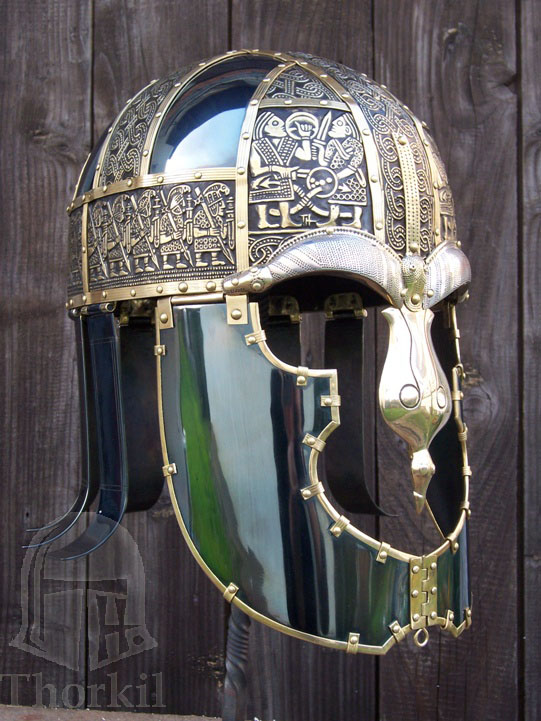
I thought I would share this image of the new V14 by Grzegorz (Thorkil) commisioned by my eldest son, which he recieved today...he is very happy with it!

Whoa. That's amazing, David.
Hi Nathan,
I must admit I was left breathless as my son opened the bo and unwrapped the helm, a testament to Greg's ever improving skills and talents. Here is a picture of my son in his generic Frankish kit.
best
Dave
 Attachment: 67.42 KB
Attachment: 67.42 KB
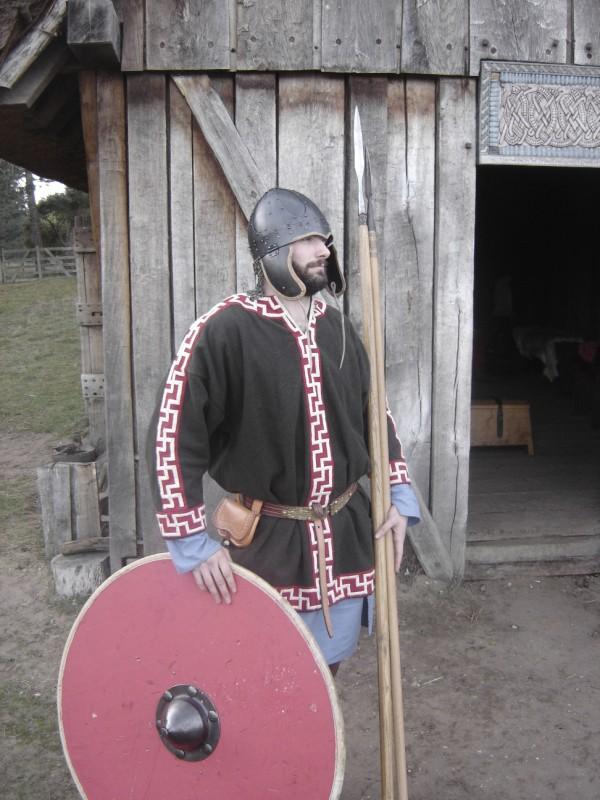
I must admit I was left breathless as my son opened the bo and unwrapped the helm, a testament to Greg's ever improving skills and talents. Here is a picture of my son in his generic Frankish kit.
best
Dave

| Quote: |
| I thought I would share this image of the new V14 by Grzegorz (Thorkil) commisioned by my eldest son, which he recieved today...he is very happy with it! |
Oh my. :eek:
Give your son my congratulations on an outstanding acquisition.
Wow!!! That helm is incredible.
Literally breathtaking!
Yes, That is really a spectacular helm. Very beautiful indeed!
A really interesting period, the early English, although a west teutonic group primarily, no doubt included a good many Scandinavians proper - the Jutes and Angles were from the Jutland neck after all, whilst the Wulfing dynasty in E Anglia were probably Swedes. Early Anglian dialects of English also show strong affinities with proto Norse rather than the other Ingaevonic tongues, thus a Vendel Swede, a Dane, Geat or Engle would have been pretty much indistinguishable.
In Beowulf only one Englishman rates a mention - Offa of Angeln; the remainimg heroes are Danes, Swedes, Geats. Jutes and Half-Danes!! this shows that to the early English, their Scandinavian roots were hugely important, obviously this attitude was coloured somewhat by the later Danish incursions, by which time the English had been Christianised but despite the Christian veneer sagas involving the likes of Ingeld and Hrothgar remained hugely popular amonst a still largely heathen English folk, moch to the annoyance of their more educated and Christ-worshiping priests.
In Beowulf only one Englishman rates a mention - Offa of Angeln; the remainimg heroes are Danes, Swedes, Geats. Jutes and Half-Danes!! this shows that to the early English, their Scandinavian roots were hugely important, obviously this attitude was coloured somewhat by the later Danish incursions, by which time the English had been Christianised but despite the Christian veneer sagas involving the likes of Ingeld and Hrothgar remained hugely popular amonst a still largely heathen English folk, moch to the annoyance of their more educated and Christ-worshiping priests.
PS Do you have moose in Sweden? Thought they were Elk - a moose is an American elk isn't it? Here in England we'd call a Swedish elk an elk! I know an elk in the US is just a large deer - confusing. How about some lemming skin?
| Stephen Wheatley wrote: |
| PS Do you have moose in Sweden? Thought they were Elk - a moose is an American elk isn't it? Here in England we'd call a Swedish elk an elk! I know an elk in the US is just a large deer - confusing. How about some lemming skin? |
http://en.wikipedia.org/wiki/Moose
http://en.wikipedia.org/wiki/Elk
Having been born and raised in the mountainous areas of Southeastern Idaho I was fortunate to be able to live in close proximity to these majestic animals. Here's some pics:
 Attachment: 68.5 KB
Attachment: 68.5 KB
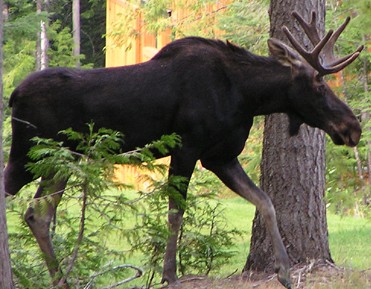
Alces Alces; known as the European Elk
 Attachment: 218.47 KB
Attachment: 218.47 KB
Cervus elaphus nelsoni ; Rocky Mountain Elk [ Download ]

Alces Alces; known as the European Elk
Cervus elaphus nelsoni ; Rocky Mountain Elk [ Download ]
Hi guys
'Thanks and I'll be sure to pass on your kind comments to Thorkil and my son, .
regards
Dave
'Thanks and I'll be sure to pass on your kind comments to Thorkil and my son, .
regards
Dave
I have a couple of questions about the belt buckles of this period. To my knowledge there are three main parts: the plate, the buckle, and the tongue/pin. Which parts of these belts rotate?
I have seen some examples of reproductions where the buckle is stationary and the tongue moves (http://medievalwares.com/images/BB22.jpg). This seems to be supported by the Saint-Denis finds, which have clay molds casting separate tongues (http://www.saint-denis.culture.fr/en/3_1b_fondeur.htm).
I have also seen some examples where the buckle definitely rotates (http://www.museedestempsbarbares.fr/images/si...yen/91.jpg) (http://www.museumoflondon.org.uk/archive/exhi...le_med.jpg) (http://art.thewalters.org/image.aspx?url=PS1_...;size=full). I am unsure if the tongue on these examples is stationary or if it also rotates.
So, how do the plate, tongue, and buckle all fit together?
Also, how do these buckles look on the back? Do they have a separate back plate to keep the rivets from cutting into the belt?
Here's a couple of really nice examples from Musee des Temps Barbares just for show: http://www.museedestempsbarbares.fr/fr/fetes-...and/24.jpg, http://www.museedestempsbarbares.fr/fr/fetes-...and/26.jpg
I have seen some examples of reproductions where the buckle is stationary and the tongue moves (http://medievalwares.com/images/BB22.jpg). This seems to be supported by the Saint-Denis finds, which have clay molds casting separate tongues (http://www.saint-denis.culture.fr/en/3_1b_fondeur.htm).
I have also seen some examples where the buckle definitely rotates (http://www.museedestempsbarbares.fr/images/si...yen/91.jpg) (http://www.museumoflondon.org.uk/archive/exhi...le_med.jpg) (http://art.thewalters.org/image.aspx?url=PS1_...;size=full). I am unsure if the tongue on these examples is stationary or if it also rotates.
So, how do the plate, tongue, and buckle all fit together?
Also, how do these buckles look on the back? Do they have a separate back plate to keep the rivets from cutting into the belt?
Here's a couple of really nice examples from Musee des Temps Barbares just for show: http://www.museedestempsbarbares.fr/fr/fetes-...and/24.jpg, http://www.museedestempsbarbares.fr/fr/fetes-...and/26.jpg
There are a number of different ways to attach buckles to straps in this period.
The simplest, and probably most common, was to loop the material through the (simple) buckle loop and stitch it to itself.
Sometimes "shoe-shaped rivets" or other decorative pierced lugs were pushed through the textile, or through a slit in the leather, and then wired or laced on.
Simple buckle loops could also have a sheet metal buckle plate, which might be decorated.
Higher end composite or integral plate buckles were riveted directly to the belt, or were cast with two or three pieced lugs on the undersides.
The lug system seems to have started in the late Roman east, and was then copied by the barbarian west.
 Attachment: 12.27 KB
Attachment: 12.27 KB
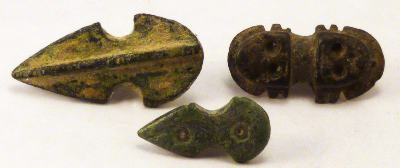
Anglo-Saxon shoe shaped rivets and Merovingian rivet. Largest rivet is 2.9cm.
 Attachment: 11.81 KB
Attachment: 11.81 KB
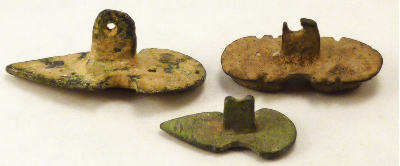
 Attachment: 20.39 KB
Attachment: 20.39 KB
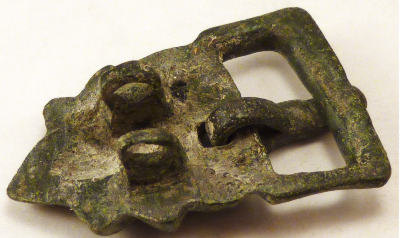
 Attachment: 27.23 KB
Attachment: 27.23 KB
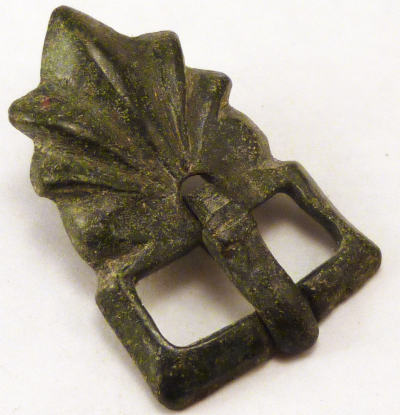
Late Roman buckle. 3.4cm.
The simplest, and probably most common, was to loop the material through the (simple) buckle loop and stitch it to itself.
Sometimes "shoe-shaped rivets" or other decorative pierced lugs were pushed through the textile, or through a slit in the leather, and then wired or laced on.
Simple buckle loops could also have a sheet metal buckle plate, which might be decorated.
Higher end composite or integral plate buckles were riveted directly to the belt, or were cast with two or three pieced lugs on the undersides.
The lug system seems to have started in the late Roman east, and was then copied by the barbarian west.

Anglo-Saxon shoe shaped rivets and Merovingian rivet. Largest rivet is 2.9cm.



Late Roman buckle. 3.4cm.
Last edited by Mark Shier on Fri 17 Dec, 2010 7:24 pm; edited 2 times in total
Continental Saxon "Scorpion" integral plate buckle. 4.4cm wide. This may be a shoe buckle.
 Attachment: 17.77 KB
Attachment: 17.77 KB
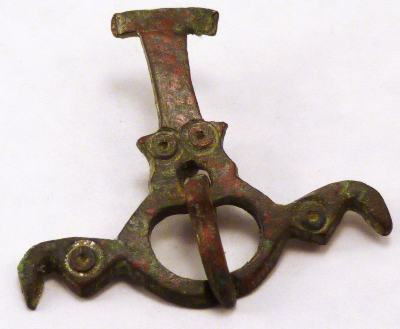
 Attachment: 19.02 KB
Attachment: 19.02 KB
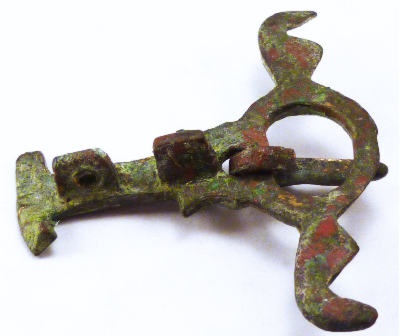


Anglo-Saxon integral plate buckle, 6.2cm. This is a low end version of the fancy gold composite AS buckles, which usually had a moving buckle loop.
 Attachment: 14.28 KB
Attachment: 14.28 KB
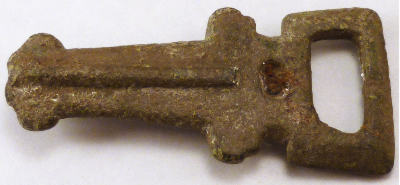
 Attachment: 14.05 KB
Attachment: 14.05 KB
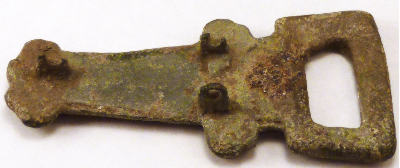


Page 11 of 15
You cannot post new topics in this forumYou cannot reply to topics in this forum
You cannot edit your posts in this forum
You cannot delete your posts in this forum
You cannot vote in polls in this forum
You cannot attach files in this forum
You can download files in this forum
All contents © Copyright 2003-2006 myArmoury.com — All rights reserved
Discussion forums powered by phpBB © The phpBB Group
Switch to the Full-featured Version of the forum
Discussion forums powered by phpBB © The phpBB Group
Switch to the Full-featured Version of the forum